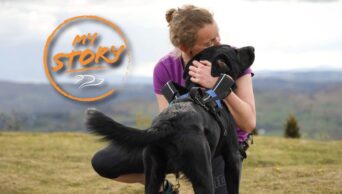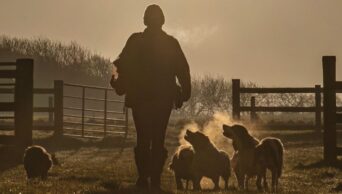“How Canicross changed my life at 59”
Blog , +2
August 17, 2022
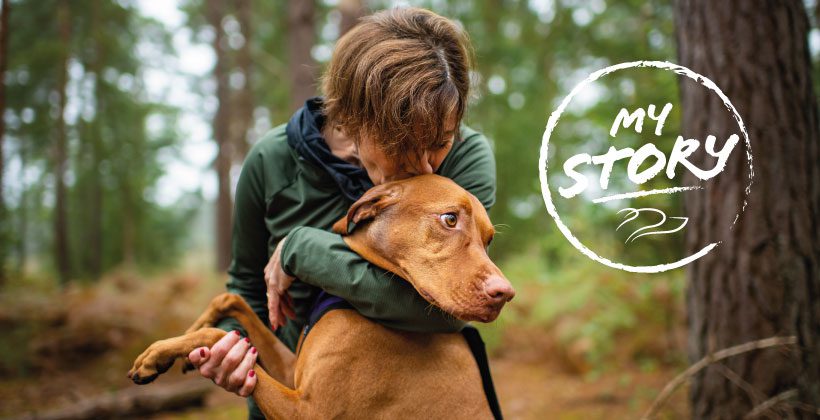
image credit: dogfit uk
Written by DogFit UK
Back in October 2020, we launched our first ever DogFit podcast. We kicked off with an episode we called ‘questions, fun and fears’, which led to a really fun and interesting conversation with Carolyne and Kelly, two complete newbies to Canicross. We talked about the first steps towards getting started and about gaining confidence on the trails.
Carolyne had just completed the DogFit Couch to 5K training programme with her vizsla, Ted, and she shared her experiences with us. She told us how, as a complete non-runner, she had fallen in love with Canicross. For anyone new to the sport, we highly recommend that you listen to it. What she says is as relevant now as it was back then.
Carolyne has now returned to talk to us again at DogFit and we are very excited to find out what she and Ted have been up to since we last spoke.
When we spoke to you before, you and Ted had just completed our DogFit Couch to 5K programme. Fast-forward 18 months and tell us what distances are you running now? How did you build up your distances and what are you up to today?
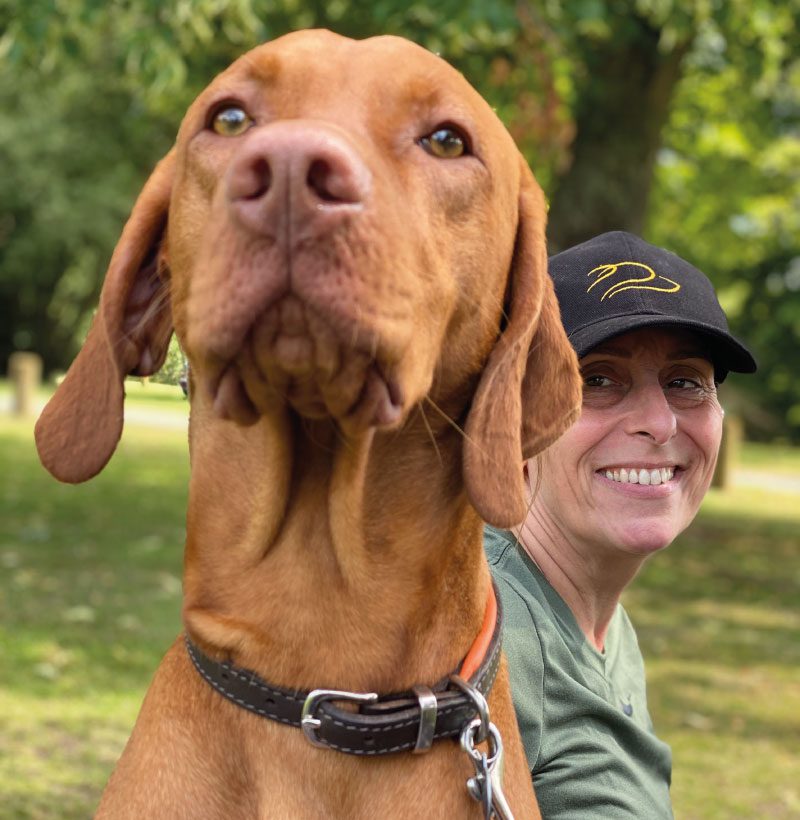
Things have gone from strength to strength and I love it. When we last spoke, Ted was about 14 months old and we had just started out in Canicross. After we did our initial Couch to 5K we joined a DogFit group and ran with one of the trainers there. We then ran several 5K and 10K races together and it has grown from there. A longer race that Ted and I did together was the Gower Half-marathon in Wales. It was epic – pure mud! It was very hilly too. Canicrossers will know that, if ever you want your dog to be pulling you, it is when you are going uphill. Ted was amazing!
I also did the London Marathon without Ted at the age of 59 – can you believe it? Canicross has truly changed my life for the better. I’m not just saying that. I love my dog and love that we can run together and achieve so much.
Tell us more about the Gower Half-marathon and how you and ted built up to do that. Also, I presume you did some of your training for the London Marathon with Ted?
I started by running every single weekend – sometimes during the week too if I could fit it in. I would gradually extend the time Ted and I were out. As it got close to the Gower Half-marathon, we added to our programme even more. Sometimes, when I was out running and finding it tough, I would call a friend to motivate me as I went along. It was a long time to be out training and I often really felt it in my legs. For my dog, however, training was like a walk in the park. He was so happy to be out with me. He didn’t need a scheduled running programme in the same way that I did as a human.

When it came to the London Marathon, I didn’t run that with Ted on the day, although I would have loved to have brought him along. In the same way as I did for the Gower Half-marathon, I built up my training programme gradually, adding time on week by week to strengthen my legs and stamina. I just kept doing that until I was able to run the full length. I never felt like I had to train – I wanted to, and that made a huge difference to my mindset.
You have to put a lot of time into training for a marathon and that was the hardest part of it. There were times when I really didn’t want to go out, but I thought about Ted and carried on regardless. He provided great psychological inspiration because he doesn’t care how I felt, he just wanted to run! I am lucky enough to live in an area with lots of soft ground nearby, which has been great as you can’t really run on pavements with a dog – it’s not right for them. So, I would take him into the forest and run on soft ground with him instead. When the distances got longer. I would do part of the session with him and then bring him home again so he didn’t get over tired. Even so, his presence got me started and saw me through the first part of my training session and on to marathon success!
Would you do another marathon?
I have signed up for the next one, actually. I ran for a charity the first time called Antibiotic Research UK. They were amazing. It was rather funny actually. The lady who signed me up invited me out for coffee. I remember saying to my husband that it was rather odd for a charity to do that. So, I met her for coffee locally and it wasn’t until we were sitting down that I thought to ask her how many of us would be running for the charity. It turned out that I was the only one! That was a bit of a shock and it made me realise that I really couldn’t back out – I had to do it for them as much as for myself! I raised over £3,000 for them in the end, which was great.
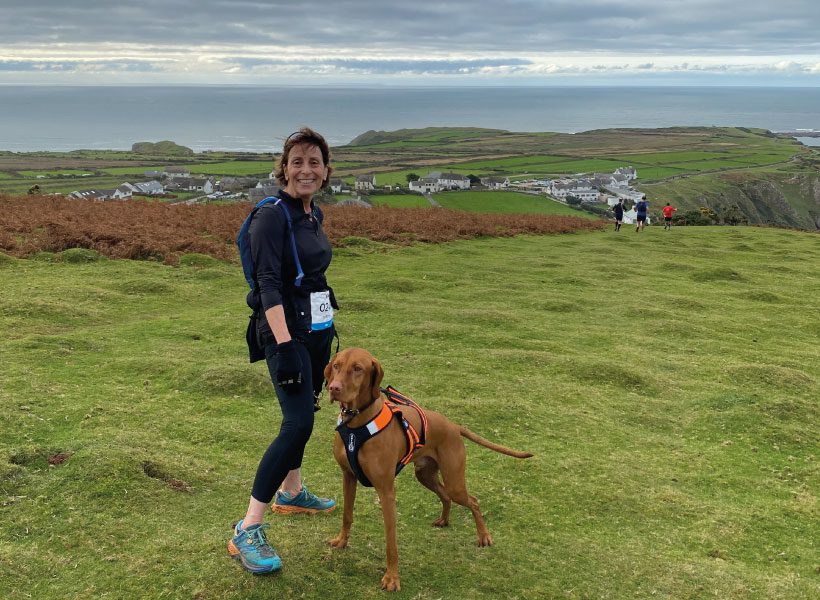
Tell us about the Gower Half-marathon where you were allowed to run with Ted. How was that, turning up with him on the day?
Ted is my running partner and when I found out that we could do the event together, I felt far less nervous. We had to get on a coach to get to the starting point., Ted had never been on a coach before, so he was a bit unsure. We got to the other end and we all piled out. It was absolutely freezing. He was really good despite all of that. We started off by going up a really steep hill – there is a picture of me and Ted doing that somewhere. The rain and the mud were epic too. Yet he kept going and going. His tail was up and he seemed to be having a good time.
The views were stunning. I had to hook him up on the way back down as he was pulling me along so much. He kept my spirits up and it was a really great thing to do. When we crossed the finish line on the beach, we saw the flags waving and my family cheering us on. People were cheering more for Ted than me, actually! They seemed to forget that I was attached to him… He thought he had won the whole thing.
You waited until Ted was 14 months before starting Canicross with him, going through the training programme and joining a group. How was all that for you and what did you think about the social side of the sport?
Yes, I waited until Ted was old enough before I started running with him because I know that, with dogs, you need to wait until their bones and growth plates are mature enough to withstand the impact of running. Running with a group helped me to learn how to direct Ted along the route. When we run with others, we need to act as if we are in a pack so we don’t all bump into each other. To start with, Ted would bounce around trying to play with the bungee line. He would sometimes even be far behind me when he should have been out in front!
Being in the group encouraged him to run properly. He had to be taught how everything worked as much as I did and the other Canicrossers’ support really helped us both. I had to learn how to give him the correct instructions for the situation at hand. One key thing I had to master was how to get him to stay ‘with me’ when we were running hills. Dogs tend to bomb it down hills as fast as they can, rather than staying close to the person on the other end of the line. I had a few trips and falls while he was learning how to respond to that one!
I have a fantastic group of friends to run with. I would never have met them otherwise. That’s one of the wonderful things about sport. When you find a group of people who have the same passion as you, they won’t judge you, whatever level you are at. Whatever do you, wherever you come from, it’s just all about the dogs, getting out there and running. Everyone waits for each other and it’s all very social.
When we spoke before, you described yourself as not being built for running and said that Ted was energetic and took no prisoners. It sounds like you have now moved on from that and trained him well in all the commands. You seem to have quite a different response from him now.
I really do. Dogs are the best personal trainers you will ever have. They show you so much love and are always so excited to be with you. In the beginning, it’s true that I wasn’t built for running. I am now! I would never have believed I could have achieved what I have done over the past year or so. That is quite an emotional thing for me. I was falling into the overweight category and never thought I could run such long distances or lose weight in such a healthy way.
I used to tell people that I wanted to run a marathon one day, but never actually did it. I thought that if I didn’t actually try, no-one could say that I had failed. Thanks to Canicrossing, however, I achieved it. Looking at it from the outside, I sometimes think, is it really me doing all of this? My body has changed so much and my outlook is completely different too.
What about the dog’s side of things? Not only do you get fitter and build a special bond between you and your dog, but it gives them the chance to socialise with other dogs and increase their confidence too. How would you say that Canicrossing has helped Ted?
I have worked hard on Ted’s commands and he is very good at recall now. I occasionally let him free run when we are out together and if he goes off in a different direction, he will come back on my command, which works really well. When he sees a squirrel, he can suddenly dash off after it, but he isn’t very good at actually catching them, so all is well there. It’s great to see him enjoy himself in his natural element, but also know that he will respond readily to my commands when necessary.
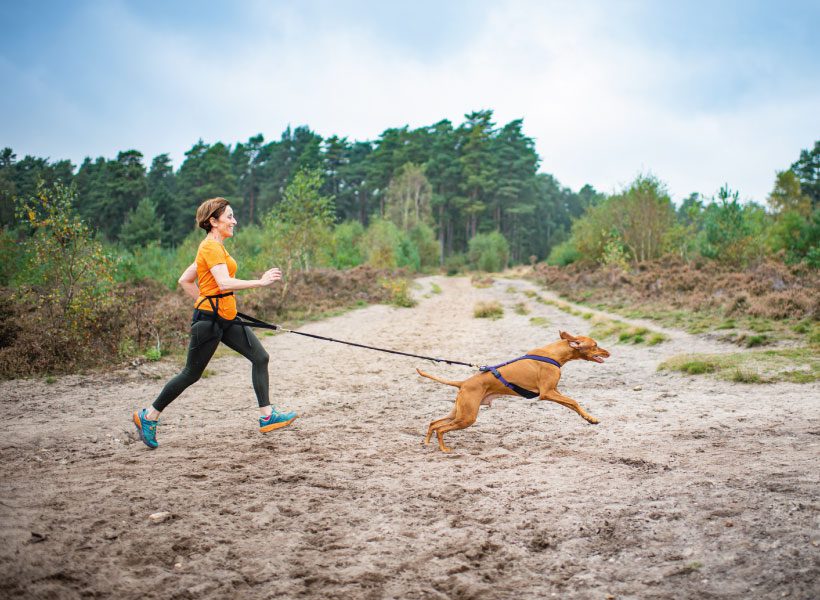
Ted is quite strong. Other people with large or strong dogs could be a bit anxious or put off by having a powerful dog that could pull them over halfway along. What would you say to those people to reassure them?
I totally understand that. Ted can pull really hard at times like a train. He has never pulled me right over though, and when we first started running, Ted used to go behind me as well as in front. Control is really important with stronger dogs. Also, the choice of harness. It needs to be very supportive. I don’t feel afraid that he is going to pull me over or go at the wrong angle when I’m wearing mine. I can bend my knees slightly to bring him back under control I have run him on a short bungee too, which gives even more control and support.
I love it. If I’m out running and see someone running with a dog on a lead, I almost always feel compelled to stop them and talk about the joys of using a harness. I’ve done park runs with Ted a few times and people do come over and ask me about the kit.
Yes, support and comfort really are key to Canicross. Even if you are out walking, you can still use the same hands-free kit.
People don’t tend to realise that. If you are older, perhaps, and can’t quite hold on to a dog so well during a walk, it can really help. When I have had Ted on a lead and collar and he has suddenly seen a squirrel, he can really pull and hurt my arm. It’s definitely a good idea to get a harness for walking if you want to avoid that. You can pull the dog in when you need to and keep that control. I also love the fact that you can make the lead shorter if you want to, which helps when you need to cross a road or get the dog to walk to your pace, not theirs. Using controls and commands when out for a walk is very useful – dogs don’t speak human, after all – so they help you keep the dog going where and how you want them to.
What would you say has been the best thing about Canicross for you?
I would say the best thing has been the benefits it has brought to my health. I am turning 60 this year and I want to be a fit, healthy woman for as long as I possibly can. We all get older and can experience different ailments, but life goes on. I want to feel good for a long time to come, both in myself and in my head. We have all had an interesting couple of years with challenges to both physical and mental health. There is nothing better for mental health than getting out there for a run in the fresh air. I’m no fitness guru, but Canicross has done wonders for me. If you have a dog, you have to walk them, so why not combine that with getting fitter yourself? Both of you can enjoy the benefits of keeping as fit as you possibly can. Add in a group of friends to run with and laugh with, and the endorphins and good feelings will only increase.
What would you tell yourself when you were first starting out, given what you know about Canicrossing now?
So many things! Don’t overthink it. Don’t ever think you can’t do it, or are not fit enough to take part. I probably wasn’t really fit enough at the beginning, but I still went out and had a go. You can start at any level, even just going for a walk with the dog on the harness, and build up from there. I used to purposely not do things so that I wouldn’t have to say that I had failed. That’s crazy! Trying new things opens up a whole new you. Go for it!
Finally, what’s next for you and Ted?
We have done a few 5Ks and 10Ks together since the Gower Half-marathon. I now want to do some Canicrossing type events with obstacle courses added in. There’s one where the dogs go through water and that sounds like amazing fun. I’d also like to do more half-marathons as it’s great to be out there running for that length of time. Who knows, maybe I’ll add to my stash of medals in the future!
If you would like to listen to this podcast you can find it here

